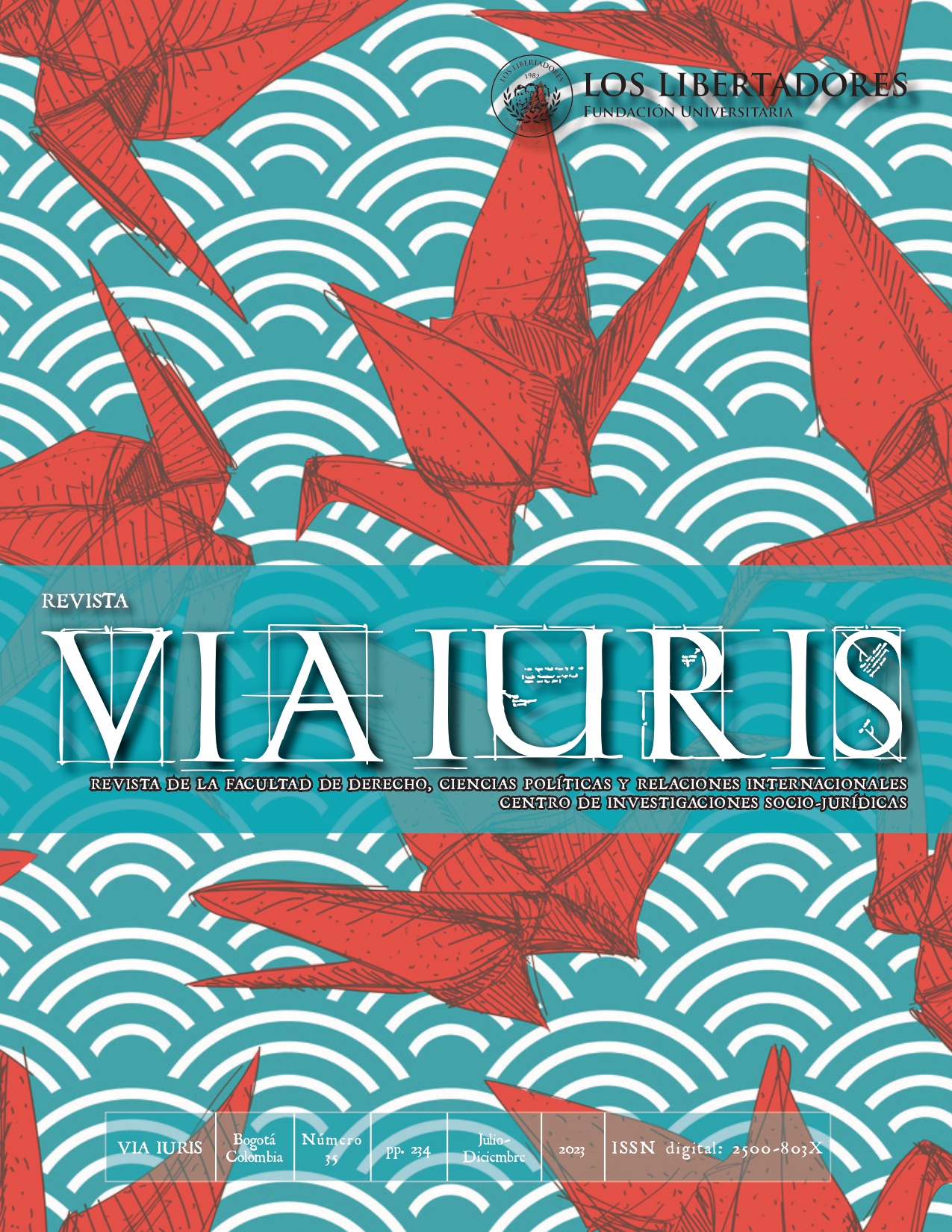Corporate group regime in Colombia: A comparison subsidiary liability in South Korea and Japan.
DOI:
https://doi.org/10.37511/viaiuris.n35a4Keywords:
Corporate groups, subsidiary liability, control, Chaebol, Keiretsu, parent company, subsidiariesAbstract
This paper develops a comparative law exercise between the legal systems of Colombia, South Korea and Japan in relation to the regulation of corporate groups, for which the research object of this paper focuses on the legal problem of whether the current Colombian regulation on subsidiary liability favours the parent companies over the controlled companies in the event of insolvency of the latter. To this end, the concept of business groups, Chaebol and Keiretsu is explored in order to delimit the object of research and determine their main similarities, such as control, the search for common objectives and a hierarchical structure, as well as their differences, such as the cross-shareholding schemes of the Chaebol and Keiretsu, and the influence of family structures in decision-making; Finally, subsidiary liability is addressed, where, based on the regulation of business groups in Colombia, the Chaebols in South Korea and the Keiretsu in Japan, it is observed that Colombian legislation is much more restrictive in terms of business groups than the regulations in South Korea and Japan.
Downloads
References
Betancourt, B., y Morris, E. (2000). Diseño organizacional - la estructura: de las estructuras verticales a las organizaciones horizontales (1ª. ed.). MBA Ediciones.
Brañas, J. (2002). El crecimiento económico de Corea del Sur 1961-1987. Aspectos Sociológicos. [Tesis Doctoral no publicada]. Universidad Autónoma de Barcelona.
Casajuana, J. (2017) La integración vertical e integración horizontal entre empresas. JL Casajuana Abogados. http://jlcasajuanaabogados.com/la-integracion-vertical-e-integracion-horizontal-entre-empresas/
Congreso de la República de Colombia (20 de diciembre de 1995). Por la cual se modifica el Libro II del Código de Comercio, se expide un nuevo régimen de procesos concursales y se dictan otras disposiciones. [Ley 222 de 1995]. D.O: 42.156.
Congreso de la República de Colombia (2006). Por la cual se establece el Régimen de Insolvencia Empresarial en la República de Colombia y se dictan otras disposiciones. [Ley 1116 de 2006]. D.O: 46.494.
Congreso de la República de Colombia (2012). Por medio de la cual se expide el Código General del Proceso y se dictan otras disposiciones. [Ley 1564 de 2012]. D.O: 48.489
Correa, F. (2017). Desarrollo económico de Japón: de la génesis al llamado milagro económico. Revista Facultad de Ciencias Económicasm 25(1), 57-73.
Corte Constitucional. Sala Plena. (9 de octubre de 1997). Sentencia C-517. [M.P. José Gregorio Hernández Galindo].
Corte Suprema de Justicia. (3 de agosto de 2006). Sentencia Responsabilidad Industria Hullera S.A. [Sala de Casación Civil. Exp. No 2001-0364-01.].
Corte Suprema de Justicia. (25 de julio de 2018). Sentencia SC-2837. [Sala de Casación Civil. Exp N° 05001 31 03 013 2001 00115 01.].
Corte Suprema de Justicia. (26 de agosto de 2019). Sentencia SC-3414. [Sala de Casación Civil. Exp N° 76001-31-03-013-2004-00011-01.].
Dieta Nacional de Japón. Acto No. 172 de 1952.
Dieta Nacional de Japón. Acto No. 154 del 13 de diciembre, 2002.
Dieta Nacional de Japón. Acto No. 75 del 2 de junio, 2004.
DiMaggio, P. (2001). The twenty-first-century firm: Changing economic organization in international perspective. Princeton University Press.
Fernández, Z. (2001). Las relaciones banca-industria: un tiempo para la revisión. Economía Industrial, 341, 13-24.
Flath, D. (1996). The Keiretsu Puzzle. Journal of the Japanese and International Economies. 10, 101-121.
Fontdeglória, X. (2017). Corea del Sur quiere poner coto al poder de sus grandes conglomerados.
Gaitán Rozo, A. (2011). Grupos empresariales y control de sociedades en Colombia. Superintendencia de Sociedades.
Haksoo, K. (2007). Korea's Newly Enacted Unified Bankruptcy Act: The Role Of The Japanese Law Translation - [Law text] - Companies Act. (2019).
Murillo, D., y Sung Y. (2013). Understanding Korean Capitalism: Chaebols and their Corporate Governance. EsadeGeo, 33, 1-13. https://itemsweb.esade.edu/research/esadegeo/201309ChaebolsMurilloSungEN.pdf
Navarro, J. (2013). Hablemos de chaebols. https://www.elblogsalmon.com/empresas/hablemos-de-chaebols
New Act In Facilitating (Or Discouraging) The Transfer Of Corporate Control. UCLA Pacific Basin Law Journal, 24, 201-224. https://escholarship.org/content/qt71m657sc
Nishijima, S. (2009). Desarrollo económico de Japón y política industrial de Japón: implicaciones para países en desarrollo. Discussion Paper Instituto de Investigación para Economía y Administración (RIEB), 246, 1-19. http://www.paginaspersonales.unam.mx/files/165/JAPON2.pdf
Presidencia de la República de Colombia. (Código de Comercio). [Decreto 410 de 1971]. D.O: 33.339.
Presidencia de la República de Colombia. (26 de mayo de 2011). [Decreto 1749 de 2011]. D.O: 48.081.
Presidencia de la República de Colombia. (26 de mayo de 2015). [Decreto 1074 de 2015]. D.O: 49.523.
Reyes Villamizar, F. (2004). Derecho Societario, Tomo 1 (1ª. ed.). Bogotá: Editorial Temis.
Santos, J., y Jaramillo, C. (2012). Responsabilidad civil: Vol. I (3ª. Ed.). Pontificia Universidad Javeriana:Temis.
Haggard, S., Lim, W., y Kim, E. (2003). Economic Crisis and Corporate Restructuring in Korea: Reforming the Chaebol (1ª. ed). Cambridge University Press.
Sheldon, P., y Rhee, J. (2010). Business groups and regulatory institutions: Korea`s chaebols, cross-company shareholding and the East Asian crisis. Asian Business & Managmement, 9, 499-523.
Superintendencia de Sociedades. (2011). Guía Práctica Régimen de Matrices y Subordinadas. https://www.supersociedades.gov.co/supervision_societaria/dir_especialesyempresariales/Documents/GUIA_MATRICES_BAJA8.pdf
Superintendencia de Sociedades. Grupos Empresariales. oficio Nº 220-059116 del 15 de marzo de 2017. https://www.supersociedades.gov.co/nuestra_entidad/normatividad/normatividad_conceptos_juridicos/OFICIO%20220-059116.pdf
Superintendencia de Sociedades. Responsabilidad de la Matriz por Obligaciones de su Subordinada. oficio Nº 220-168863 del 6 de noviembre de 2018. https://www.supersociedades.gov.co/nuestra_entidad/normatividad/normatividad_conceptos_juridicos/OFICIO_220-168863_DE_2018.pdf
Superintendencia de Sociedades. Grupo Empresarial – Matrices y Subordinadas – Responsabilidad Subsidiaria de la Matriz. oficio Nº 220- 152943 del 02 de agosto de 2023. https://www.supersociedades.gov.co/documents/107391/159040/OFICIO++++220-+152943++++02+DE+AGOSTO+DE+2023.pdf/0c758dda-e919-8740-488c-c88517eeeefe?version=1.0&t=1692197192624
Tamayo Jaramillo, J. (2007). Tratado de responsabilidad civil: Vol. I (2a. ed.). Legis Editores.
Ryu, H., y Chae, S.-J. (2021). Family firms, chaebol affiliations, and Corporate Social Responsibility. Sustainability, 13(6), 3016. https://doi.org/10.3390/su13063016
Vargas, R. (2018). Imbricación: qué es y cuáles son sus implicaciones. https://www.asuntoslegales.com.co/analisis/raul-vargas-2775178/imbricacion-que-es-y-cuales-son-sus-implicaciones-2775170
Downloads
Published
Versions
- 2023-07-20 (2)
- 2024-02-27 (1)
Issue
Section
License
Copyright (c) 2024 Revista Vía Iuris

This work is licensed under a Creative Commons Attribution-NonCommercial-ShareAlike 4.0 International License.

This work is licensed under a Licencia Creative Commons Atribución-NoComercial-


